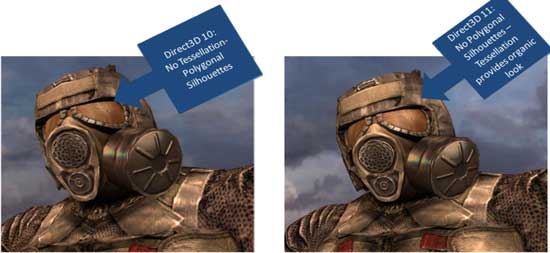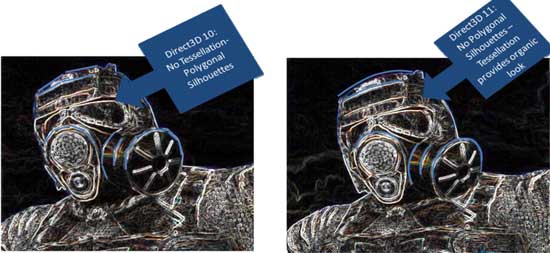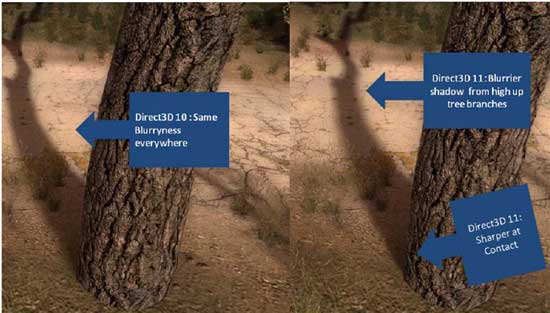The Radeon HD 5970: Completing AMD's Takeover of the High End GPU Market
by Ryan Smith on November 18, 2009 12:00 AM EST- Posted in
- GPUs
STALKER: Call of Pripyat – A Peak at More DX11
For the 5970 launch, AMD sent over a special benchmark version of STALKER: Call of Pripyat, which has since then been made public at the GSC Game World STALKER website. STALKER is another one of AMD’s big DX11 titles, as it’s technically the 2nd DX11 title to launch and the first such title to implement most of the major DX11 features. The Russian version actually shipped back in October, and the German version shipped 2 weeks ago. However we’re told that these versions only had an early-stage implementation of the DX11 feature set, and that the demo is more representative of where the game is after patching and what it will be like when it finally launches in the rest of the world early next year.
Since it’s an unplayable demo, we’re going to forgo any competitive benchmarking (it’s not as if anyone else has a DX11 card anyhow) but we will look quickly at the performance impact of these features, since this is the closest thing we have to a playable game using them at this point in time.
STALKER makes use of 3 major DX11 features.
- High Definition Ambient Occlusion using compute shaders
- Tessellation
- Contact hardening shadows
We’ve already seen HDAO with Battleforge, and it’s no different here in STALKER. And we’ve covered tessellation in-depth in our look at DirectX 11.
So today, let’s talk about contact hardening shadows. Shadowing has been on a path of particularly noticeable evolution. The first real shadows, seen in such titles as Doom 3, had very hard edges. Stencil buffering was used to determine where a shadow would fall, and that was it. Diffusion was never taken into account. Newer games have since taken diffusion into account to generate soft shadows, but these shadows aren’t necessarily accurate. Currently soft shadows are implemented with a fixed degree of softness around the entire shadow, which isn’t how shadows really work.
With diffusion, the softness of a shadow increases with the distance of the casting object from the surface the shadow is being displayed on. AMD loves to use a light pole as an example, as the top of the shadow should be softer than the bottom. These shadows are referred to as contact hardening shadows, and the use of them in games has been limited by the expense of calculating them using the DX10 feature set. STALKER allows for contact hardening shadows with DX10.1 and DX11 mode.
Unfortunately a moving benchmark makes for a poor source to take screenshots, so we’re going to stick with AMD’s reference shots here. Only contact hardening shadows are particularly noticeable in the benchmark; tessellation and HDAO are there, but are virtually impossible to catch given the zoomed-out nature of the benchmark and the fact that it’s constantly in motion.
The benchmark comes with 4 different flybys, each under different environmental conditions: day, night, day with rain, and day with sun shafts. We’ve gone ahead and benchmarked the game during the “day” flyby, once with the DX11 feature set enabled, and once with it disabled. This means for DX11 mode tessellation, contact hardening shadows, and Ultra HDAO were enabled; and for DX10 tessellation and contact hardening shadows were disabled, and High HDAO was used.
| STALKER: Call of Pripyat, Day Benchmark | DX10 | DX11 |
| Average FPS | 31.4 | 35.1 |
| Minimum FPS | 17.7 | 21.2 |
Enabling all of these features actually causes performance to rise, thanks to the more efficient implementation of HDAO as a compute shader as opposed to a pixel shader. Ultimately what this means is that unless HDAO is disabled entirely, STALKER is going to be faster on a DX11 card running the entire DX11 feature set than it will be when running the DX10 feature set.
The biggest performance hit, and the reason we’re not breaking 40fps here even with a 5970, is due to how anti-aliasing is implemented in STALKER. As it uses deferred rendering, the game does its own anti-aliasing. We used 4X MSAA here along with per-pixel alpha transparency testing (basically Adaptive/Transparancy AA). Disabling anti-aliasing improves performance dramatically.













114 Comments
View All Comments
Paladin1211 - Saturday, November 21, 2009 - link
To be precise, anything above the monitor refresh rate is not going to be recognizable. Mine maxed out at 60Hz 1920x1200. Correct me if I'm wrong.Thanks :)
noquarter - Saturday, November 21, 2009 - link
If you read AnandTech's 'Triple Buffering: Why We Love It' article, there is a very slight advantage at more than 60fps even though the display is only running at ~60Hz. If the GPU finishes rendering a frame immediately after the display refresh then that frame will be 16ms stale by the time the display shows it as it won't have the next one ready in time. If someone started coming around the corner while that frame is stale it'd be 32ms (stale frame then fresh frame) before the first indicator showed up. This is simplified as with v-sync off you'll just get torn frames but the idea is still there.To me, it's not a big deal, but if you're looking at a person with quick reaction speed of 180ms, 32ms of waiting for frames to catch up could be significant I guess. If you increase the fps past 60 you're more likely to have a fresh frame rendered right before each display refresh.
T2k - Friday, November 20, 2009 - link
Seriously: is he no more...? :DXeroG1 - Thursday, November 19, 2009 - link
OK, so seriously, did you really take a $600 video card and benchmark Crysis Warhead without turning it all the way up? The chart says "Gamer Quality + Enthusiast Shaders". I'm wondering if that's really how you guys benchmarked it, or if the chart is just off. But if not, the claim "Crysis hasn’t quite fallen yet, but it’s very close" seems a little odd, given that you still don't have all the settings turned all the way up.Incidentally, I'm running a GeForce 9800 GTX (not plus) and a Core2Duo E8550, and I play Warhead at all settings enthusiast, no AA, at 1600x900. At those settings, it's playable for me. People constantly complain about performance on that title, but really if you just turn down the resolution, it scales pretty well and still looks better than anything else on the market IMHO.
XeroG1 - Thursday, November 19, 2009 - link
Er, oops - that was supposed to say "E8500", not "E8550", since there is no 8550.mapesdhs - Thursday, November 19, 2009 - link
Carnildo writes:
> ... I was the administrator for a CAVE system. ...
Ditto! :D
> ... ported a number of 3D shooters to the platform. You haven't
> lived until you've seen a life-sized opponent come around the
> corner and start blasting away at you.
Indeed, Quake2 is amazing in a CAVE, especially with both the player
and the gun separately motion tracking - crouch behind a wall and be
able to stick your arm up to fire over the wall - awesome! But more
than anything as you say, it's the 3D effect which makes the experience.
As for surround-vision in general... Eyefinity? Ha! THIS is what
you want:
http://www.sgidepot.co.uk/misc/lockheed_cave.jpg">http://www.sgidepot.co.uk/misc/lockheed_cave.jpg
270 degree wraparound, 6-channel CAVE (Lockheed flight sim).
I have an SGI VHS demo of it somewhere, must dig it out sometime.
Oh, YouTube has some movies of people playing Quake2 in CAVE
systems. The only movie I have of me in the CAVE I ran was
a piece taken of my using COVISE visualisation software:
http://www.sgidepot.co.uk/misc/iancovise.avi">http://www.sgidepot.co.uk/misc/iancovise.avi
Naturally, filming a CAVE in this way merely shows a double-image.
Re people commenting on GPU power now exceeding the demands for
a single display...
What I've long wanted to see in games is proper modelling of
volumetric effects such as water, snow, ice, fire, mud, rain, etc.
Couldn't all this excess GPU power be channeled into ways of better
representing such things? It would be so cool to be able to have
genuinely new effects in games such as naturally flowing lava, or
an avalanche, or a flood, tidal wave, storm, landslide, etc. By this
I mean it being done so that how the substance behaves is governed
by the environment in a natural way (physics), not hard coded. So far,
anything like this is just simulated - objects involved are not
physically modelled and don't interact in any real way. Rain is
a good example - it never accumulates, flows, etc. Snow has weight,
flowing water can make things move, knock you over, etc.
One other thing occurs to me: perhaps we're approaching a point
where a single CPU is just not enough to handle what is now possible
at the top-end of gaming. To move them beyond just having ever higher
resolutions, maybe one CPU with more & more cores isn't going to
work that well. Could there ever be a market for high-end PC
gaming with 2-socket mbds? I do not mean XEON mbds as used for
servers though. Just thoughts...
Ian.
gorgid - Thursday, November 19, 2009 - link
WITH THEIR CARDS ASUS PROVIDES THE SOFTWARE WHERE YOU CAN ADJUST CORE AND MEMORY VOLTAGES. YOU CAN ADJUST CORE VOLTAGE UP TO 1.4VREAD THAT:
http://www.xtremesystems.org/forums/showthread.php...">http://www.xtremesystems.org/forums/sho...cd1d6d10...
I ORDERED ONE FROM HERE:
http://www.provantage.com/asus-eah5970g2dis2gd5a~7...">http://www.provantage.com/asus-eah5970g2dis2gd5a~7...
K1rkl4nd - Wednesday, November 18, 2009 - link
Am I the only one waiting for TI to come out with a 3x3 grid of 1080p DLPs? You'd think if they can wedge ~2.2 million mini-mirrors on a chip, they should be able to scale that up to a native 5760x3240. Then they could buddy up with Dell and sell it as an Alienware premium package of display + computer capable of using it.skrewler2 - Wednesday, November 18, 2009 - link
When can we see benchmarks of 2x 5970 in CF?Mr Perfect - Wednesday, November 18, 2009 - link
"This means that it’s not just a bit quieter to sound meters, but it really comes across that way to human ears too"Have you considered using the dBA filter rather then just raw dB? dBA is weighted to measure the tones that the human ear is most sensitive to, so noise-oriented sites like SPCR use dBA instead.